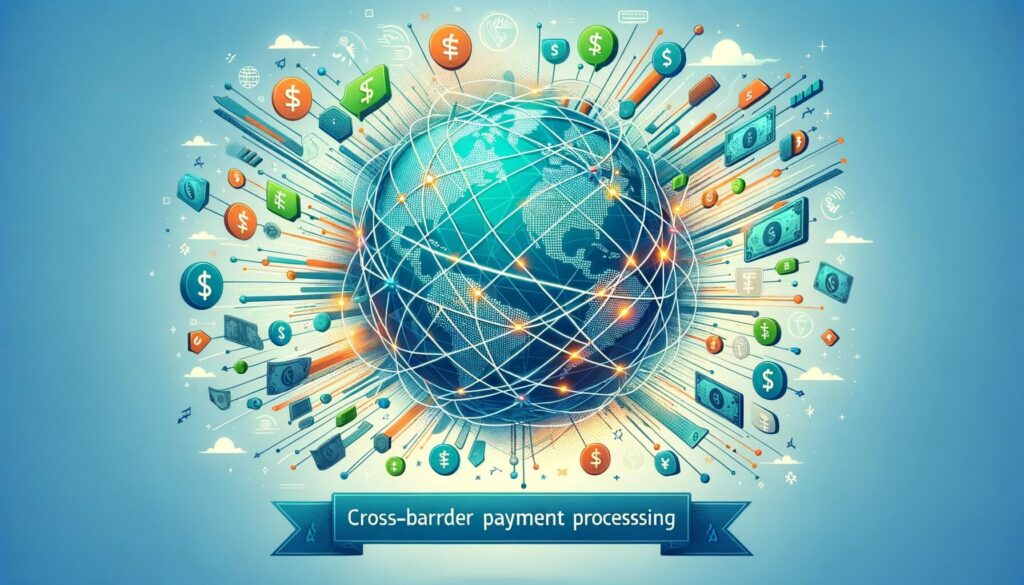
By JosephineJHenry May 13, 2025
In today’s global economy, businesses of all sizes are increasingly engaging in cross-border transactions. As a result, understanding cross-border payment processing has become essential for companies looking to expand their reach and tap into new markets.
This comprehensive guide will provide you with everything you need to know about cross-border payment processing, including how it works, factors to consider, benefits, common issues, best practices, emerging trends, FAQs, and a conclusion.
Introduction to Cross-Border Payment Processing

Cross-border payment processing refers to the transfer of funds between parties located in different countries. This process involves various financial institutions, payment networks, and regulatory bodies to facilitate the movement of money across borders. With the rise of e-commerce and global trade, cross-border payment processing has become a critical component of international business operations.
Businesses engage in cross-border payment processing for a variety of reasons, including paying suppliers, receiving payments from customers, and managing foreign currency exchange. However, navigating the complexities of cross-border payments can be challenging, as each country has its own regulations, currencies, and payment systems.
Understanding how cross-border payment processing works is essential for businesses looking to streamline their international transactions and avoid costly mistakes.
How Cross-Border Payment Processing Works

Cross-border payment processing involves several steps to ensure that funds are transferred securely and efficiently between parties in different countries. The process typically begins with the sender initiating a payment through their bank or payment provider. The payment is then routed through various intermediaries, such as correspondent banks and payment networks, before reaching the recipient’s bank account.
One of the key challenges in cross-border payment processing is currency conversion. When sending funds to a different country, the sender’s currency must be converted into the recipient’s currency at the prevailing exchange rate. This process can result in additional fees and delays, as exchange rates fluctuate constantly and may vary between different financial institutions.
To facilitate cross-border payments, financial institutions use a variety of payment methods, including wire transfers, international ACH transfers, and online payment platforms. Each method has its own advantages and limitations, depending on factors such as speed, cost, and security. By understanding the different payment methods available, businesses can choose the most suitable option for their specific needs.
Factors to Consider in Cross-Border Payment Processing

When engaging in cross-border payment processing, businesses must consider several factors to ensure a smooth and efficient transaction. Some of the key factors to consider include:
1. Regulatory Compliance: Different countries have varying regulations governing cross-border payments, including anti-money laundering (AML) and know your customer (KYC) requirements. Businesses must comply with these regulations to avoid legal issues and financial penalties.
2. Exchange Rates: Fluctuations in exchange rates can impact the cost of cross-border payments. Businesses should monitor exchange rates closely and consider using hedging strategies to mitigate currency risk.
3. Payment Security: Ensuring the security of cross-border payments is essential to protect sensitive financial information and prevent fraud. Businesses should use secure payment platforms and encryption technologies to safeguard their transactions.
4. Payment Speed: The speed of cross-border payments can vary depending on the payment method used and the countries involved. Businesses should consider the urgency of their transactions and choose a payment method that meets their timeline requirements.
5. Cost: Cross-border payments can incur various fees, including transaction fees, currency conversion fees, and intermediary fees. Businesses should compare the costs of different payment methods and providers to minimize expenses.
By considering these factors, businesses can optimize their cross-border payment processing and avoid potential pitfalls that may arise during international transactions.
Benefits of Cross-Border Payment Processing

Cross-border payment processing offers several benefits for businesses looking to expand their global reach and streamline their international transactions. Some of the key benefits include:
1. Increased Market Access: By engaging in cross-border payment processing, businesses can access new markets and reach customers in different countries. This can help businesses diversify their revenue streams and grow their customer base.
2. Improved Cash Flow: Efficient cross-border payment processing can help businesses manage their cash flow more effectively by facilitating timely payments and reducing payment delays. This can improve liquidity and support business operations.
3. Cost Savings: By choosing the right payment methods and providers, businesses can reduce the costs associated with cross-border payments, such as transaction fees and currency conversion fees. This can result in significant savings over time.
4. Enhanced Customer Experience: Providing customers with convenient and secure payment options can enhance their overall experience and build trust in the business. Cross-border payment processing allows businesses to offer flexible payment solutions that cater to the needs of their international customers.
5. Competitive Advantage: Businesses that excel in cross-border payment processing can gain a competitive edge in the global marketplace. By offering seamless and efficient payment solutions, businesses can attract international customers and differentiate themselves from competitors.
Overall, cross-border payment processing can help businesses expand their reach, improve their financial performance, and enhance their customer relationships. By leveraging the benefits of cross-border payments, businesses can unlock new opportunities for growth and success in the international market.
Common Issues in Cross-Border Payment Processing
Despite the benefits of cross-border payment processing, businesses may encounter various challenges and issues when conducting international transactions. Some of the common issues in cross-border payment processing include:
1. Currency Fluctuations: Exchange rate volatility can impact the cost of cross-border payments and result in unexpected expenses for businesses. Businesses must monitor exchange rates closely and implement risk management strategies to mitigate currency risk.
2. Payment Delays: Cross-border payments can experience delays due to factors such as time zone differences, banking holidays, and intermediary processing times. These delays can disrupt business operations and affect cash flow management.
3. Compliance Issues: Regulatory requirements for cross-border payments can be complex and vary between countries. Businesses must ensure compliance with AML, KYC, and other regulations to avoid legal repercussions and reputational damage.
4. Security Risks: Cross-border payments are vulnerable to fraud and cybersecurity threats, such as phishing attacks and data breaches. Businesses must implement robust security measures to protect sensitive financial information and prevent unauthorized access.
5. Limited Payment Options: Some countries may have restrictions on certain payment methods or currencies, limiting the options available for cross-border payments. Businesses must navigate these limitations and choose alternative payment solutions that meet their needs.
By addressing these common issues proactively and implementing best practices for cross-border payment processing, businesses can minimize risks and optimize their international transactions.
Best Practices for Cross-Border Payment Processing
To ensure successful cross-border payment processing, businesses should follow best practices that promote efficiency, security, and compliance. Some of the best practices for cross-border payment processing include:
1. Conduct Due Diligence: Before engaging in cross-border payments, businesses should conduct thorough due diligence on their partners, suppliers, and customers to verify their identities and assess their risk profile. This can help prevent fraud and compliance issues.
2. Choose Reliable Payment Providers: Selecting reputable payment providers with a proven track record in cross-border payments is essential for ensuring the security and reliability of transactions. Businesses should research and compare different providers to find the best fit for their needs.
3. Monitor Exchange Rates: Stay informed about exchange rate fluctuations and trends to make informed decisions about currency conversions and hedging strategies. Businesses can use financial tools and platforms to monitor exchange rates in real-time and minimize currency risk.
4. Implement Multi-Currency Accounts: Maintaining multi-currency accounts can streamline cross-border payments by allowing businesses to hold funds in different currencies and avoid frequent currency conversions. This can reduce costs and simplify international transactions.
5. Automate Payment Processes: Automating cross-border payment processes can improve efficiency, reduce errors, and accelerate transaction times. Businesses can use payment automation tools and platforms to schedule payments, track transactions, and reconcile accounts seamlessly.
By following these best practices, businesses can enhance the effectiveness of their cross-border payment processing and overcome common challenges associated with international transactions.
Emerging Trends in Cross-Border Payment Processing
The landscape of cross-border payment processing is constantly evolving, driven by technological advancements, regulatory changes, and shifting consumer preferences. Some of the emerging trends in cross-border payment processing include:
1. Blockchain Technology: Blockchain technology is revolutionizing cross-border payments by enabling secure, transparent, and decentralized transactions. Blockchain-based payment platforms offer faster settlement times, lower costs, and enhanced security for international transfers.
2. Instant Payments: The demand for instant payments is growing among businesses and consumers, driving the adoption of real-time payment systems for cross-border transactions. Instant payment solutions offer immediate fund transfers and improved cash flow management.
3. Mobile Payments: Mobile payment solutions are gaining popularity for cross-border transactions, allowing users to send and receive funds conveniently through their smartphones. Mobile payment apps offer flexibility, speed, and accessibility for international payments.
4. Regulatory Changes: Regulatory developments, such as the implementation of the Payment Services Directive 2 (PSD2) in Europe, are shaping the future of cross-border payment processing. Compliance with new regulations and standards is essential for businesses operating in the global marketplace.
5. Cross-Border E-Commerce: The growth of cross-border e-commerce is driving demand for seamless and secure payment solutions that cater to online shoppers worldwide. Businesses are investing in cross-border payment platforms that support multiple currencies, languages, and payment methods.
By staying informed about these emerging trends and adapting to the changing landscape of cross-border payment processing, businesses can stay ahead of the curve and capitalize on new opportunities for growth and innovation.
FAQs About Cross-Border Payment Processing
Q1. What are the common payment methods used for cross-border transactions?
Answer: Common payment methods for cross-border transactions include wire transfers, international ACH transfers, credit/debit card payments, and online payment platforms like PayPal and Stripe.
Q2. How long does it take for a cross-border payment to reach its destination?
Answer: The time it takes for a cross-border payment to reach its destination can vary depending on the payment method used, the countries involved, and any intermediary processing times. Wire transfers typically take 1-5 business days, while international ACH transfers may take 3-7 business days.
Q3. What are the fees associated with cross-border payment processing?
Answer: Fees associated with cross-border payment processing may include transaction fees, currency conversion fees, intermediary fees, and bank charges. The total cost of a cross-border payment depends on the payment method used and the amount being transferred.
Q4. How can businesses mitigate currency risk in cross-border payments?
Answer: Businesses can mitigate currency risk in cross-border payments by monitoring exchange rates, using hedging strategies like forward contracts and options, and maintaining multi-currency accounts to minimize currency conversions.
Q5. What are the compliance requirements for cross-border payments?
Answer: Compliance requirements for cross-border payments include anti-money laundering (AML) regulations, know your customer (KYC) requirements, and sanctions screening. Businesses must comply with these regulations to prevent fraud and ensure the security of their transactions.
Conclusion
In conclusion, understanding cross-border payment processing is essential for businesses looking to expand their global reach, streamline their international transactions, and capitalize on new opportunities in the global marketplace. By following best practices, staying informed about emerging trends, and addressing common issues proactively, businesses can optimize their cross-border payment processing and achieve success in the international arena.
As the landscape of cross-border payment processing continues to evolve, businesses must adapt to technological advancements, regulatory changes, and shifting consumer preferences to stay competitive and meet the demands of a globalized economy. By leveraging the benefits of cross-border payments and overcoming challenges through strategic planning and innovation, businesses can unlock new possibilities for growth and prosperity in an interconnected world.